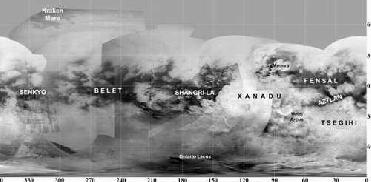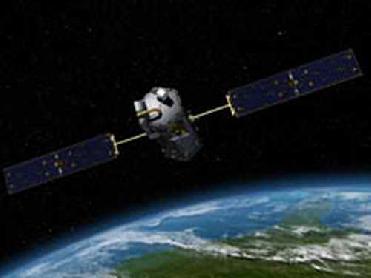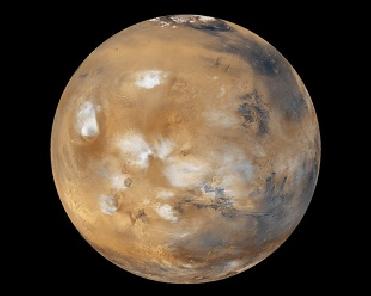
These updated maps of Saturn's moon Titan, consisting of data from the Cassini imaging science subsystem, include Cassini's August 2008 imaging of the moon's northern hemisphere. NASA
WASHINGTON (BNS): Just as changing seasons on the earth, Titan too is experiencing weather changes. Images taken by NASA�s Cassini spacecraft show the presence of lakes of liquid hydrocarbons and changes brought about by the rainfall in the lakes.
For many years scientists have suspected that dark areas near the north and south poles of Saturn's largest satellite might be liquid-filled lakes. An article published in the January 29 edition of the journal Geophysical Research Letters reveals new lake features in Titan�s South Polar Region not seen in images taken a year earlier. The presence of extensive cloud systems covering the area in the intervening year suggests that the new lakes could be the result of a large rainstorm and that some lakes may thus owe their presence, size and distribution across Titan's surface to the moon's weather and changing seasons, Cassini scientists said.
Scientists said that the high-resolution cameras of Cassini's Imaging Science Subsystem (ISS) have surveyed Titan�s entire surface at a global scale. An updated Titan map, released recently by the Cassini Imaging Team, includes the first near-infrared images of the leading hemisphere portion of Titan's northern �lake district� captured on August 15-16, 2008. (The leading hemisphere of a moon is that which always points in the direction of motion as the moon orbits the planet.) These ISS images complement existing high-resolution data from Cassini's Visible and Infrared Mapping Spectrometer (VIMS) and RADAR instruments, scientists said.
The researchers said that the mosaics visible on the south pole of Saturn's moon Titan, show changes in dark areas that may be lakes filled by seasonal rains of liquid hydrocarbons. Such observations have documented greater stores of liquid methane in the northern hemisphere than in the southern hemisphere. And, as the northern hemisphere moves toward summer, Cassini scientists predict large convective cloud systems will form there and precipitation greater than that inferred in the south could further fill the northern lakes with hydrocarbons.
�Some of the north polar lakes are large. If full, Kraken Mare -- at 400,000 sq km -- would be almost five times the size of North America's Lake Superior. All the North Polar dark 'lake' areas observed by ISS total more than 510,000 sq km -- almost 40 percent larger than Earth's largest lake, the Caspian Sea,� the scientists said.
However, evaporation from these large surface reservoirs is not great enough to replenish the methane lost from the atmosphere by rainfall and by the formation and eventual deposition on the surface of methane-derived haze particles, the researchers said.
Dr. Elizabeth Turtle, Cassini imaging team associate at the Johns Hopkins University Applied Physics Lab in Laurel, and lead author of the article said that a recent study suggested that there's not enough liquid methane on Titan's surface to re-supply the atmosphere over long geologic timescales. �Our new map provides more coverage of Titan's poles, but even if all of the features we see there were filled with liquid methane, there's still not enough to sustain the atmosphere for more than 10 million years,� Turtle said.
Combined with previous analysis, the new observations suggest that underground methane reservoirs must exist, Turtle said. Titan is the only satellite in the solar system with a thick atmosphere in which a complex organic chemistry occurs. �It's unique. How long Titan's atmosphere has existed or can continue to exist is still an open question,� Turtle said.
That question and others related to the moon�s meteorology and its seasonal cycles may be better explained by the distribution of liquids on the surface. Scientists also are investigating why liquids collect at the poles rather than low latitudes, where dunes are common instead.
Dr Tony DelGenio of NASA's Goddard Institute for Space Studies in New York, a co-author and a member of the Cassini imaging team said that Titan's tropics may be fairly dry because they only experience brief episodes of rainfall in the spring and fall as peak sunlight shifts between the hemispheres. �It will be interesting to find out whether or not clouds and temporary lakes form near the equator in the next few years,� DelGenio said.
The scientists said that Titan and the transformations on its surface brought about by the changing seasons will continue to be a major target of investigation throughout Cassini's Equinox mission.
 Previous Article
Previous Article Next Article
Next Article











The Indian Air Force, in its flight trials evaluation report submitted before the Defence Ministry l..
view articleAn insight into the Medium Multi-Role Combat Aircraft competition...
view articleSky enthusiasts can now spot the International Space Station (ISS) commanded by Indian-American astr..
view article